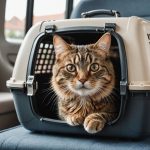Essential Features of a High-Quality Cat Travel Carrier
When selecting cat travel carriers, understanding the essential features can greatly enhance your pet’s travel experience. The size of the carrier is paramount for both comfort and safety. A carrier that is too small can cause stress and restrict movement, while one too large can make your cat feel insecure. Ideally, the carrier should allow your cat to stand, turn around, and lie down comfortably.
Ventilation is another crucial feature to consider, especially during long journeys. Proper airflow prevents overheating and keeps your cat calm, reducing stress. Look for carriers with multiple mesh windows or perforated walls to ensure adequate ventilation. This will help in maintaining a healthy and comfortable environment, even for extended periods.
Also to see : Comprehensive blueprint for crafting the ideal saltwater clownfish aquarium setup
Safety Considerations
Safety should always be a top priority when choosing any carrier. Effective safety mechanisms such as reliable locks and harness attachments can prevent escapades and ensure your pet stays secure. Ensure the closures and zippers are robust and difficult for a crafty cat to open. Additionally, consider carriers with internal harnesses or tether points for added security during travel, providing peace of mind to pet owners.
Focusing on these carrier features will contribute to a safe, comfortable, and pleasant travel experience for both you and your furry companion.
Have you seen this : Spotting signs of canine overexertion: essential cues to observe in training sessions
Types of Cat Travel Carriers
When it comes to cat travel carriers, selecting the right type can greatly impact your pet’s comfort and safety during trips. The two primary options are soft-sided carriers and hard-sided carriers. Understanding their features and specific uses will help you make an informed decision.
Soft-Sided Carriers
Soft-sided carriers are popular for their lightweight and flexible design, making them easy to carry and store. They’re ideal for short trips to the vet or airplane travel where space may be tight. The fabric construction provides comfort, while mesh panels offer ventilation and visibility, keeping your cat calm and secure. However, these carriers may not be as durable in a rugged environment and can lack the structural protection found in their hard-sided counterparts.
Hard-Sided Carriers
Hard-sided carriers boast a rigid structure, offering superior protection and durability for longer journeys or trips in uneven terrain. They can withstand the occasional bumps and jostles without compromising the cat’s safety. Featuring a secure, easy-to-clean plastic design, they are perfect for car travel or when stability is a priority. Nevertheless, they might be cumbersome, especially for those who prioritize portability.
Other Carrier Variations
For those looking for alternatives, backpack carriers offer hands-free convenience, ideal for brief outings or trekking. Meanwhile, wheeled carriers provide ease of movement through airports or urban landscapes. Each variant caters to unique pet travel needs, ensuring both comfort and practicality.
Evaluating Carrier Quality
Understanding the quality assessment of carriers is crucial for ensuring long-term satisfaction and safety. One measure of quality comes from industry standards that define safety and durability requirements. These standards help ensure that carriers can withstand daily use and protect users from potential hazards. When selecting a carrier, it’s essential to check whether it complies with these guidelines.
In addition to industry benchmarks, analyzing consumer reviews provides valuable insights into the carrier’s performance in real-world scenarios. Customer feedback often highlights practical issues such as ease of use, comfort, and longevity. Reviews can reveal trends in repetitive faults or strengths, offering a comprehensive picture beyond the manufacturer’s claims.
Another critical factor in assessing carrier quality is examining the materials used in construction. High-quality materials contribute significantly to a product’s durability and resistance to wear and tear. Materials like reinforced plastics or stainless steel can indicate a commitment to long-lasting performance. Always prioritise carriers constructed from robust materials that also enhance safety.
In essence, the balance between adhering to industry standards, understanding consumer experiences, and evaluating the materials used, creates a holistic approach to assessing carrier quality. Engaging with these factors helps consumers make informed decisions, ensuring that they invest in reliable, durable, and safe products.
Brand Recommendations for Cat Travel Carriers
When it comes to selecting cat travel carriers, one needs to consider both popular brands and trusted manufacturers. These factors ensure safety and comfort for our feline friends during travels.
Top Recommended Brands
Numerous brands stand out for their quality and reliability. Renowned names like Petmate and Sherpa are leaders in the market, known for their durable materials and comfort-focused designs. Key features that set these brands apart include lightweight construction, easy accessibility, and superior ventilation systems. These ensure not only ease of transport but also a stress-free environment for the pet.
Value vs. Premium Options
Understanding the distinction between budget-friendly and premium carriers is crucial. Budget-friendly options often focus on simplicity and essential features. In contrast, high-end choices offer additional benefits like plush interiors and advanced security mechanisms. While premium models may come with a higher price tag, they often provide enhanced comfort and durability, which can make the investment worthwhile in the long run.
User Experiences
User feedback indicates a growing preference for carriers combining functionality with style. Positive outcomes often revolve around ease of cleaning and handling. Emerging trends suggest that consumers lean more towards carriers that provide both safety and aesthetics. Overall, customer reviews reveal a satisfaction trend towards brands that improve travel ease both for humans and their feline companions.
Practical Tips for Traveling with Cats
Travelling with pets can be a rewarding experience if approached with the right preparation. Incorporating effective cat travel tips ensures that your feline companion enjoys the journey too. Start by preparing your cat before the trip. Gradually acclimating them to their carrier can alleviate anxiety. Introduce short journeys to familiarise them with travel conditions, rewarding them with treats to create positive associations.
Ensuring a comfortable journey for your pet is crucial. Invest in a sturdy, well-ventilated carrier with enough space for movement. Line it with a soft blanket or piece of clothing that carries your scent, offering comfort and familiarity. Monitor the temperature inside the vehicle, as pets are sensitive to extreme temperatures. Make regular stops to offer water and litter breaks.
Local pet travel regulations should not be overlooked. Check for any specific travelling with cats requirements such as health certificates or vaccinations well in advance. Research best practices in pet-friendly accommodations at your destination to ensure a seamless experience. Consider travel insurance options that cover pet-related emergencies to avoid unexpected situations.
By being thoroughly prepared and considerate of your cat’s needs, you can make your journey together as smooth and enjoyable as possible. Implementing these cat travel tips can alleviate concerns and make travelling with pets a positive experience.
Air Travel Guidelines for Cats
Navigating air travel regulations when flying with a cat can seem daunting, but understanding each airline’s specific pet policies can ease the process.
Understanding Airline Policies
Different airlines have unique airline requirements for pet carriers, often specifying dimensions that fit under the seat. Typically, carriers must be well-ventilated, leak-proof, and secure. You’ll need to provide documentation showing up-to-date vaccinations and possibly a health certificate obtained shortly before travel. Be prepared for additional fees, as airlines charge for pets onboard, often up to $125 each way.
Preparing for Security Checks
At airport security, both you and your cat must undergo screening. You may be required to carry your cat through metal detectors while the carrier is scanned separately. To ensure a smooth experience, practice keeping your cat calm, and consider using a harness for added security. Arrive early to allow extra time for this process.
Best Practices for Airborne Safety
Maximise your cat’s comfort by familiarising them with their carrier before the trip. Include a favourite blanket or toy to minimise stress. Onboard, maintain hydration and consider anxiety-reducing products recommended by your vet. These strategies can significantly enhance your pet’s ability to travel calmly, abiding by pet policies and ensuring a pleasant journey.











